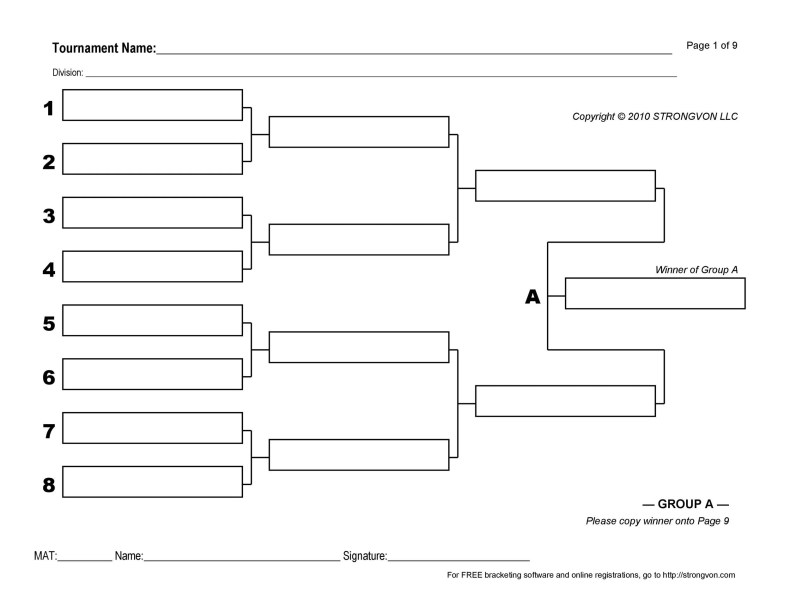Tournament Formats are way more than just brackets; they’re the backbone of competition, shaping strategy and defining the path to victory. From the cutthroat single-elimination battles to the marathon endurance of round-robin clashes, the format you choose drastically alters the playing field. We’ll break down the most popular tournament structures, exploring their strengths, weaknesses, and best-fit scenarios. Get ready to level up your tournament game!
This guide dives into five main tournament formats: single elimination, double elimination, round robin, Swiss-system, and hybrid formats. We’ll explore the mechanics of each, compare and contrast them, and offer examples of where each shines. We’ll even show you how to create your own brackets and schedules, so you can run your own killer tournament.
Double Elimination Tournaments: Tournament Formats

Double elimination tournaments offer a compelling alternative to the single-elimination format, providing competitors with a second chance to advance even after an initial loss. This structure significantly increases the fairness and competitiveness of the tournament, especially when considering the potential for upsets or close matches in the early rounds. This format is popular in many competitive gaming scenes and various sports.Double elimination tournaments are characterized by two distinct brackets: the winner’s bracket and the loser’s bracket.
Participants compete in the winner’s bracket until a single champion emerges. Players eliminated from the winner’s bracket are moved to the loser’s bracket, where they continue competing against other losers. The ultimate champion is the player who wins both the winner’s bracket final and the subsequent championship match against the winner of the loser’s bracket.
Double Elimination Tournament Structure
The structure of a double elimination tournament can be visualized using a bracket. Here’s an example illustrating a hypothetical tournament for eight participants:
| Winner’s Bracket | Loser’s Bracket |
|---|---|
| Player 1 vs Player 8 | |
| Player 2 vs Player 7 | |
| Player 3 vs Player 6 | Loser of 1 vs 8 |
| Player 4 vs Player 5 | Loser of 2 vs 7 |
| Winner (1/8) vs Winner (2/7) | Loser of 3 vs 6 vs Loser of 1 vs 8 |
| Winner (3/6) vs Winner (4/5) | Loser of 4 vs 5 vs Loser of 2 vs 7 |
| Winner’s Bracket Final | Loser of Winner (1/8) vs Winner (2/7) vs Loser of Winner (3/6) vs Winner (4/5) |
| Champion | Championship Match |
This table depicts a simple 8-participant bracket. The winner’s bracket proceeds as a standard single-elimination bracket. Losers are then fed into the loser’s bracket, where they face other eliminated competitors. The winner of the loser’s bracket then faces the winner of the winner’s bracket in a final championship match.
Comparison of Double and Single Elimination Tournaments
The key difference between double and single elimination lies in the number of losses allowed before elimination. In single elimination, a single loss results in immediate elimination. Double elimination allows for a second loss before a player is eliminated. This results in a longer tournament with more matches, but it provides a more equitable opportunity for all participants, particularly those who might have had an off day in their first match.
Single elimination is quicker and simpler to organize, but it’s less forgiving of early setbacks.
Impact of Winner’s and Loser’s Brackets
The winner’s bracket determines the path to a quick victory, while the loser’s bracket provides a second chance for players to redeem themselves. A strong performance in the winner’s bracket often leads to a more favorable position in the final match, as the winner avoids the grueling matches of the loser’s bracket. However, the loser’s bracket can be a proving ground, allowing players to improve their game and potentially overcome their earlier defeats to ultimately challenge the winner’s bracket champion.
The winner of the loser’s bracket often demonstrates resilience and adaptability, having navigated a more challenging path to the championship match. The final match is a true test of skill and endurance, pitting the undefeated winner’s bracket champion against the victor of the arduous loser’s bracket.
Hypothetical Double Elimination Bracket for 8 Participants
The table above provides a visual representation of a hypothetical double-elimination tournament bracket for eight participants. The matches are organized sequentially, with losers from the winner’s bracket feeding into the loser’s bracket. The final match pits the winner of the winner’s bracket against the winner of the loser’s bracket, determining the overall tournament champion. This format ensures that even with an early loss, competitors have the opportunity to continue competing and potentially claim the championship.
Round Robin Tournaments

Round robin tournaments, also known as all-play-all tournaments, are a staple in many competitive settings. Unlike elimination tournaments where a single loss can end your run, round robins ensure every participant faces every other participant. This leads to a more comprehensive evaluation of skill and a more balanced competition, although it does require a significantly higher time commitment.Round robin tournaments involve each participant playing every other participant once.
The scheduling of these matches can be tricky, especially as the number of participants grows. The simplest approach involves a straightforward, systematic pairing of players. For an even number of players, this is relatively easy; for an odd number, it requires a bit more finesse. The key is to ensure fair play and to minimize idle time for any given player.
Scheduling a Round Robin Tournament
Scheduling a round robin tournament efficiently is crucial for smooth operation. A common approach is to use a round-robin scheduling algorithm. These algorithms aim to minimize the total number of rounds required and evenly distribute the playing times. For an even number of participants, this is relatively straightforward, but for an odd number, a slightly more complex system is needed.
Imagine a scenario with seven teams; each team plays six games. One way to approach this is to assign one team to a bye each round, meaning they don’t play in a given round, while the other six teams are paired off.
Scheduling a Round Robin Tournament with an Odd Number of Participants
To create a schedule for a round-robin tournament with an odd number of participants, we can use a cyclical approach. Let’s illustrate this with a tournament involving five participants (A, B, C, D, E).
- Round 1: A vs. B, C vs. D, E (bye)
- Round 2: B vs. C, D vs. E, A (bye)
- Round 3: C vs. A, E vs. B, D (bye)
- Round 4: A vs. D, B vs. E, C (bye)
- Round 5: D vs. B, E vs. C, A (bye)
Notice how each participant gets one bye and plays every other participant exactly once. This system can be expanded to accommodate larger odd numbers of participants, although the scheduling becomes more intricate.
Advantages and Disadvantages of Round Robin Tournaments
Round robin tournaments offer several advantages over elimination formats. The most significant is the fairness: every participant gets to play every other participant, providing a comprehensive assessment of skill. This eliminates the possibility of a strong team being eliminated early due to a single bad game. However, round robins are time-intensive, requiring significantly more games than elimination tournaments, making them less practical for large numbers of participants or time-constrained events.
The increased number of games also makes the overall scheduling more complex.
Suitable Scenarios for Round Robin Tournaments
Round robin formats are particularly well-suited for smaller leagues or tournaments where a thorough evaluation of all participants is crucial. Think of scenarios like local chess clubs, small-scale sports leagues, or academic debate competitions. In these contexts, the emphasis is on fair competition and overall skill assessment rather than identifying a single “winner” quickly. The time investment is justifiable given the comprehensive data gathered on participant performance.
Hybrid Tournament Formats

Hybrid tournament formats offer a compelling alternative to traditional single-elimination or round-robin structures by blending the strengths of different systems. This approach allows organizers to tailor the competition to specific needs, balancing factors like fairness, time constraints, and the overall competitive experience. They’re particularly useful when dealing with a large number of participants or when you want to ensure a higher number of games for each competitor.
Examples of Hybrid Tournament Formats
Several hybrid formats exist, each with its own unique blend of features. One common example is a system where teams first compete in a round-robin group stage, and then the top teams from each group advance to a single-elimination bracket. Another approach involves using a Swiss-system format (where players are paired based on their current record) followed by a single-elimination playoff for the top finishers.
These combinations leverage the round-robin’s ability to provide many matches and the single-elimination’s clear path to a champion. The Swiss system offers a balance between fairness and efficiency.
Rationale for Using Hybrid Formats
The decision to use a hybrid format often stems from a desire to address the limitations of simpler systems. For instance, a pure round-robin format can be excessively time-consuming for large participant numbers, while a single-elimination bracket offers little opportunity for weaker teams to gain experience or demonstrate their skill against stronger opponents. Hybrids aim to mitigate these issues.
A key advantage is the increased number of matches, offering more playing time for participants and creating a more robust ranking system. This is particularly valuable in situations where team development or overall player improvement is a significant goal.
Design of a Hybrid Tournament Format: Single-Elimination with a Preliminary Round Robin
This format begins with a round-robin stage dividing participants into smaller pools. The number of pools and their sizes depend on the total number of participants. Within each pool, teams play every other team once. Following the round-robin, the top two teams from each pool advance to a single-elimination bracket. The bracket’s seeding reflects the round-robin performance, with the top-performing teams receiving advantageous seeding.
This design ensures every team plays multiple games, fostering development and providing a more comprehensive evaluation of skill.
Advantages and Disadvantages of the Proposed Hybrid Format
This hybrid format offers several advantages. Firstly, it allows for a significant number of games, giving participants more playing time and opportunities to improve. Secondly, it provides a more nuanced ranking system, as teams’ performances in the round-robin phase inform their seeding in the elimination bracket. This system is also relatively easy to understand and manage. However, the main disadvantage is the increased time commitment required compared to a simple single-elimination bracket.
The round-robin phase adds considerable time, especially with larger pools. The complexity also increases the organizational burden, requiring careful planning and scheduling. Another potential drawback is that the round-robin phase may not be entirely relevant to the final outcome if a clear dominant team emerges.
FAQ Summary
What’s the difference between a seeded and unseeded tournament?
A seeded tournament ranks participants based on skill or prior performance before the bracket is created, leading to a more balanced competition. Unseeded tournaments randomly assign participants, increasing the chance of upsets but potentially leading to easier matches for stronger players early on.
How do I handle ties in a round-robin tournament?
Tiebreakers are often used in round-robin tournaments. Common methods include comparing head-to-head results between tied teams, looking at point differentials, or using additional criteria like fewest goals allowed (in sports).
Are there any formats better for smaller groups of players?
Single or double elimination works well for smaller groups, as round robin becomes less efficient with fewer participants. A small round robin followed by a single elimination playoff could be a good hybrid approach.
What factors should I consider when choosing a tournament format?
Consider the number of participants, the time available, the desired level of competition, and the overall goals of the tournament (e.g., maximizing fairness, excitement, or efficiency).
